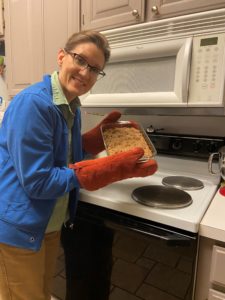Stre-e-e-tching Meals, Like They Did in the Old Days
Stre-e-e-tching Meals, Like They Did in the Old Days
by Amy Stephens, Executive Director

Amy Stephens pulls a fresh Applesauce Cake from the oven—the perfect dessert when baking staples are hard to find.
In following the Shelter-at-Home guidelines, I’m cooking more than ever—two and three meals a day! So, I find myself thinking how my Grandma Davidson, a World War II bride, cooked for her large family. (see WWII Rationing blog post) Grandma stretched the meals, she saved her bacon grease, she made do with what was available. Huh! I’m starting to do these things, too.
Did you know that if you throw a can of Spaghetti-Os into vegetable soup—it’s suddenly a kid favorite? Or that blah diced potatoes from a can will add bulk to practically any chicken dish, but almost disappear in the pan? (None of the kids have yet to ask, “What are those strange, white cubes in the casserole?”). For any dish that is remotely Mexican, just toss corn chips on top and its suddenly fancy nachos.
History of the One-Pot Meal
It was the late 1800s when American casseroles and one-pot meals grew in popularity. This is sometimes attributed to the Campbell’s Soup Company for developing condensed soups, which became a basic sauce for many recipes. During the Great Depression of the 1930s, homemakers stretched their food budgets with soups, rice and pasta–but beans were the commodity no household went without: cheap, high protein, and no refrigeration required until cooked.
I’ve discovered some of my own food stretches in just the few months that Coronavirus has adjusted my shopping and cooking habits. Of course, my ideas are not original. Cooks during the Great Depression and WWII had years to hone their skills, and Edmond was not immune to either of these economic busts. Here are a few of my “rediscovered” food stretching tips, along with a little history:
Bean Secrets
I stumbled upon my own method of stretching a big pot of beans for my family, who aren’t so jazzed about beans:
Day 1: Make big pot of pinto beans with bacon added. (They were flavorful, but the family ate without enthusiasm).
Day 2: Make Frito Chili Pie, with beans mixed in. (The kids were so excited about the Fritos that they didn’t notice the beans).
Day 3: Drain some beans and add to taco salad. (One child picked the beans out, but the others didn’t notice).
Day 4: Use leftover beans and broth as a base for vegetable soup. (No one caught on—success)!
This isn’t earth-shattering cleverness, I know—but I’ve never needed to do this before!! My grandma would be proud, while thinking, “Honey, I did that all the time.”
You “Oat” To Try This
Oats are an incredibly-overlooked food stretcher—and very filling. You can add oats to soups, meatloaf, fruit breads, energy bars and apple desserts. Two of my oat recipes are family-favorites that my mom created years ago—but they are higher on my list right now.
First, here’s an easy tuna recipe now that meat is getting harder to find: Mix oats and one egg in with a large packet of tuna. Add a little garlic salt and lemon juice before frying it up into tuna cakes. All the kids (even the non-tuna-lovers, eat these tuna cakes up.)
Second is a breakfast favorite called “Brown Sugar Cereal.” It’s easier than cooked oatmeal. Simply add dry oats to a bowl of milk and top with brown sugar. Now, I’m sure it’s the brown sugar that sold it, since I didn’t get to eat a lot of sugary cereal growing up, but it’s a tasty, filling comfort food for me.
America can also thank oats for some beautiful pieces of kitchen history. In the 1930s and into the 1940s, a Cracker Jack-type surprise was hiding in each oat container: a glass teacup or saucer! These glass “freebies” enticed the customer to then buy a matching piece. Although the glass was low-quality, molded glass, often with flaws and bubbles, it came in pretty colors. Depression-era glassware is now quite valuable. The museum has some beautiful pink pieces once owned by the Rodkey Flour Mill family.
Sweet Stretches
Speaking of sugar—rather, the lack of sugar–that was so prevalent 90 years ago, it is possible to still have dessert. “Depression Cake’” has made a resurgence during the Covid19 era. It’s also known as Poor Man’s Cake, Crazy Cake or Applesauce Cake. You’ll find a variety of recipes under any of these names. The premise is that flour, eggs, butter, or sugar may be scarce, but cake can still happen!
Most of these cake recipes use oil instead of butter, and usually 1 cup or less of that hard-to-find sugar. The ones I tried, especially those using raisins and applesauce, turned out moist and sweet–although not as sweet as today’s standard chocolate cake. The look and texture was more like “banana bread” than cake. I called it “applesauce bread” and the kids happily ate it for dessert.
Stretching into the Future
I believe I’ve come through this pandemic as a more-frugal cook, and certainly a more thoughtful meal planner. Instead of going for my standard recipes or opting to pick up tacos, I’ve found myself looking in the pantry and wondering, “What can I add to the spaghetti so that I have more leftovers?” Oh, whoops, the truth comes out. Food stretching is necessary, creative, and money saving, of course. More importantly, food stretching means less cooking for me! (And I bet Grandma knew that, too).
Related Posts
How Coronavirus Shopping Helps Us Relate to WWII Rationing
